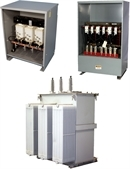Don’t Sell Rental Transformers
 MIDWESTwas recently asked again why we don’t sell some of our rental transformers. This is a question often asked after power has been restored as fast as possible using temporary equipment instead of permanent repair involving a long time delay. There are many reasons we try not to sell some of our rental power transformers. The transformer may have an attached high voltage fused switch with lightning arrestors and cabling from the switch to the transformer already installed. A rental pad mount power transformer may be mounted on a skid and already have openings for conduit for the high voltage cables and for the temporary low voltage cables. There may be a main breaker already mounted on the secondary. Some rentals have unusual voltages or many voltage taps not found on typical power transformers, making them much more valuable as a rental than for permanent installation. Some transformers are too old to justify the cost of permanent installation. Some may have unusual primary or secondary physical configurations that are okay for a temporary transformer installation, but too difficult or expensive for permanent installation. Older transformers are physically much larger than same kva and voltage new power transformers, which may make the installation of the older rental power transformer not practical or too expensive. Most of all, many requests to rent a transformer, are an urgent need to get power back up as fast as possible, which frequently means temporarily. Then the owner can more calmly figure out what they want for permanent repair, considering cost and future needs.
MIDWESTwas recently asked again why we don’t sell some of our rental transformers. This is a question often asked after power has been restored as fast as possible using temporary equipment instead of permanent repair involving a long time delay. There are many reasons we try not to sell some of our rental power transformers. The transformer may have an attached high voltage fused switch with lightning arrestors and cabling from the switch to the transformer already installed. A rental pad mount power transformer may be mounted on a skid and already have openings for conduit for the high voltage cables and for the temporary low voltage cables. There may be a main breaker already mounted on the secondary. Some rentals have unusual voltages or many voltage taps not found on typical power transformers, making them much more valuable as a rental than for permanent installation. Some transformers are too old to justify the cost of permanent installation. Some may have unusual primary or secondary physical configurations that are okay for a temporary transformer installation, but too difficult or expensive for permanent installation. Older transformers are physically much larger than same kva and voltage new power transformers, which may make the installation of the older rental power transformer not practical or too expensive. Most of all, many requests to rent a transformer, are an urgent need to get power back up as fast as possible, which frequently means temporarily. Then the owner can more calmly figure out what they want for permanent repair, considering cost and future needs.